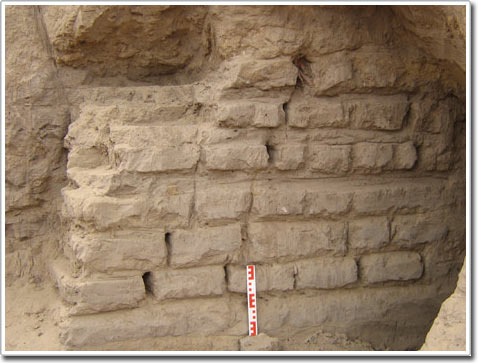The newly discovered mysterious pyramid complex in Peru
Scientists say they have discovered the remains of at least 10 pyramids on the coast of Peru, which may be a sign of a sacrificial area belonging to an obscure ancient culture.
In January, a group of construction workers working in Piura province discovered many amputated pyramids and a wide platform made from live bricks. The Peruvian Institute of Cultural Studies (INC) has sent a specialist to investigate the finding.
Last week they announced that this complex is about 3.2km long and about 1.6km wide, belonging to the ancient Vicús culture. It is possible that this place is a religious center or a tomb for nobles. Vicús civilization flourished in the desert near the northern coast of Peru about 200 BC to 300 AD, famous for decorative ceramics. Experts say humanity knows little about this civilization because its location has been heavily looted over the years.
César Santos Sánchez, the main archaeologist of Piura's INC Agency, said: 'We discovered many pyramids, at least 10. We also found a platform made of live bricks that they I estimate it could be used in burial rites. But we can't know more until the testing process progresses. '
Pieces of skull bones
This platform has an area of 25x30 m found next to the larger pyramids in the complex. Another large pyramid contains relics and a skull fragment. The fact that pieces of skull are found under the surface to a few meters, the sign of a grave is quite deep, making scientists assume that the tomb master character is in the upper class in society.
Santos thinks the complex is surrounded by four large hills: Pilán, Vicús, Chanchape, and Tongo. Santos said: 'We think that due to the geographical characteristics of the complex, this place has a strategic position.' The pyramid area is surrounded by a cemetery once attacked by grave robbers. However, the complex itself remains intact.

The live bricks of an ancient pyramid are one of the recent discoveries of the mysterious complex on the coast of Peru.Experts believe that this complex belongs to the ancient Vicús civilization and may be a religious center or a grave site for nobles.(Photo: National Geographic)
Who are Vicús?
Steve Bourget, an archaeologist at the University of Texas at Austin, said: 'Vicús civilization is interesting but poor in information. Much of what we know about them is through looting ceramic artworks. This is an important finding, because it is a small number of buildings. But it is still quite early to say something. '
Experts said the Vicús ceramic style, in many ways, is similar to the Moche style. That originated a study of the relationship of two civilizations. The most prosperous Moche civilization in the southern regions of Vicús ranges from about 100 to 750 AD, creating complex ceramics as well as gold decorations, irrigation systems and ant buildings. structure. These two cultures grow side by side in a geographical distance quite close - closer than the distance from Los Angeles to San Francisco.
Joanne Pillsbury, an archaeologist at the Dumbarton Oaks Institute in Washington DC, a research institute affiliated with Harvard University, said: 'It is possible that part of Vicús's history is related to Moche civilization. ' discovered at the time of humanity also learned more about Moche.
Pillsbury said: " People used to think that Moche is a completely independent country but it seems that this is no longer true. There may be many kingdoms in the same area of the same culture. Vicús probably also within that range of interaction. '
- Mysterious pyramid in Peru makes archaeologists' crazy
- Discovered a mysterious nude bunker in Peru
- Secret of the red pyramid in Egypt: After 141 years of decoding a part
- Discovered a huge mysterious tunnel in the Egyptian pyramid
- The hidden room in the Great Pyramid may contain the pharaoh's throne
- Pyramid: The most mysterious architecture of mankind
- The mysterious 'Pyramid' in Indonesia
- Pyramids cost 5 billion USD
- The ancient pyramid appeared in Mexico
- Mysterious giant figures in Peru
- Two cavities cannot be explained in the Great Pyramid of Egypt
- Video: The mysterious fireball lights up the sky of Peru
 Discovered an ancient centipede fossil 99 million years old
Discovered an ancient centipede fossil 99 million years old Discovered bat-like dinosaurs in China
Discovered bat-like dinosaurs in China Discovered a 200-year-old bronze cannon of the coast
Discovered a 200-year-old bronze cannon of the coast Discover 305 million-year-old spider fossils
Discover 305 million-year-old spider fossils